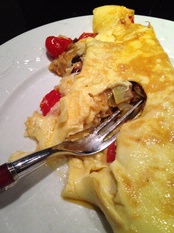WINE WITH…Leek, Mushroom and Tomato Omelets
The gifted poet Pablo Neruda wrote odes to many different foods: The potato, an artichoke, and salt, among others. So far as we know he never wrote an ode to an omelet, but had he lived a bit longer we feel confident he would have included this humble, yet ever so satisfying dish in his verse. That’s because it’s a simple preparation that provides pleasure as well as sustenance.
satisfying dish in his verse. That’s because it’s a simple preparation that provides pleasure as well as sustenance.
Most vegetables, and most meats (especially pancetta, ham or bacon), are appropriate fillings for an omelet. Cheese is almost obligatory (cheddar, Gruyère, Feta, Parmesan or a combination). Leeks add a special pungency, and mushrooms contribute their own special flavors and textures.
Omelets are easy to prepare if you make them individually (wrestling more than 3 or 4 eggs in a single pan can be challenging). So if you are making omelets for more than one person, cook them sequentially, or if you’re an adequate multi-tasker, cook two at once, in two separate pans.
One Omelet
3 tablespoons olive oil
3 tablespoons butter
1 leek, thinly sliced
salt and pepper
1 tablespoon minced onion
5-6 cherry, grape or other small tomatoes
about 2 ounces (1 cup) shitake, oyster, baby bella or just plain white mushrooms (or a combination of any or all), coarsely chopped
2-3 eggs, beaten
1/3 cup grated aged cheddar cheese
Heat 1 tablespoon each olive oil and butter in a medium sized skillet. Add the leeks and cook over medium-high heat, stirring occasionally, until the leeks are soft and tender. Season with salt and pepper then transfer the leeks to a bowl and reserve. Add another tablespoon of oil to the skillet along with the onions and tomatoes, and cook until onions are tender and the tomatoes have softened and collapsed. After seasoning them, add the tomatoes to the leeks. Place the remaining tablespoon of oil and 1 tablespoon of the butter in the pan and cook the mushrooms until they are soft; then add them to the other vegetables. Melt the remaining butter in the pan and pour in the eggs. Cook over low heat, lifting the edges a few times to let some of the uncooked egg run underneath the omelet as it develops. When the eggs are almost set on the bottom but still not fully cooked on top, spread the vegetables on one side of the omelet and sprinkle the cheese over the top. After a minute or two carefully fold the ungarnished side over the vegetables and slide the omelet onto a serving plate. If you are making a second one, tent the first one loosely with foil to keep it warm.
We find that egg dishes tend to benefit from being paired with fleshy white wines, as the creaminess of the wine complements the texture of the food. In this case, though, we found that the mushrooms in the filling enabled the omelet to shine alongside a red–specifically, a fruit-forward Pinot Noir. So while we are recommending four whites, we want to insist that this particular dish can work well with a light red as well.
Questions or Comments? Contact us at [email protected]
|
Selection
|
Approx. Price |
Comments |
|
Byron, Santa Barbara County (California) Pinot Noir 2012
|
$20 |
Tasting of bright cherry fruit with a hint of earthiness that prevents the wine from seeming candied, this Pinot seemed to give the omelet added heft and depth of flavor. A yummy match! |
|
Clayhouse, Paso Robles (California) Red Cedar Vineyard Grenache Blanc 70%/ Viognier 30% 2013
|
$23 |
This Rhône-styled Californian tastes rich and satisfying. Its almost waxy texture meshed wonderfully with the eggs. |
|
Murrieta’s Well “The Whip,” Livermore Valley (California) 2013
|
$20 |
Very similar in weight and mouthfeel to the Clayhouse white blend, this wine tastes sweeter and more vibrant. Which you will prefer depends upon whether you want a fully dry wine or like a hint of sugar. We liked both very much.
|
|
Nisia, Rueda (Spain) Verdejo “Old Vines” 2012 (Jorge Ordonez Selections; imported by The Country Vintner)
|
$16 |
A lighter wine than the other whites we are recommending, this Verdejo is nonetheless packed full with flavor—not only fruit, but spice and minerality as well. Its vivacious acidity paired especially well with the tomatoes and the leeks in the omelet. |
